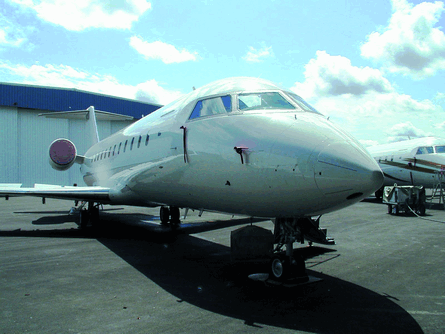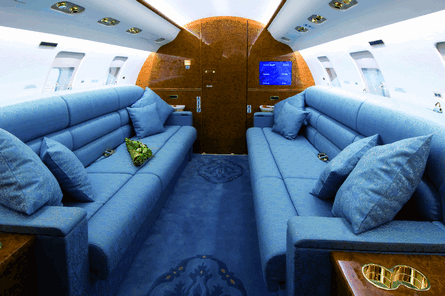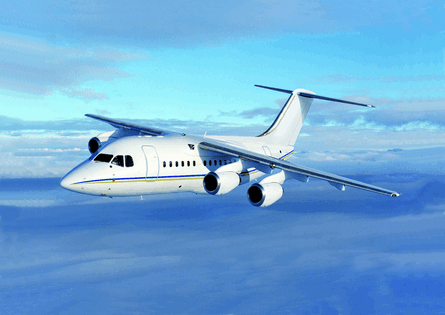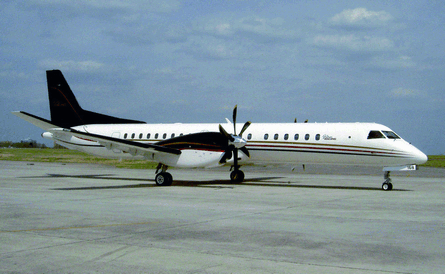Regional airliners are experiencing a renaissance thanks to the robust business aviation market. The pent-up demand for popular business jets - notably the long-range types - has resulted in bulging order backlogs and protracted delivery schedules. This in turn has propelled interest in out-of-production airliners to new heights, breathing life back into these unwanted types and throwing a much needed lifeline to the struggling lessors.
"The business for VIP airliners has never been so good," says Mike Cappuccitti, president of Project Phoenix, one of a number of companies specialising in selling executive conversions of the Bombardier CRJ200 - the 50-seat regional jet version of the Challenger 850 and arguably the leader of the regional aircraft resurgence. "Faced with such long lead times many customers are turning to older and vastly cheaper airliners either as an interim measure or as an alternative to the increasingly costly new models."
 |
|---|
© Flying Colours |
He says prices of many new business aircraft are soaring, adding that aircraft with comparable ranges and cabins such as the 850 and Embraer Legacy 600 sell for around $30 million and $25 million, respectively. But slots for these aircraft are also in short supply - 2010 for the 850 and mid-2009 for the 600.
Demand for aircraft in the long-range category - arguably the busiest market sector dominated by popular models including the Bombardier Global XRS, Dassault Falcon 7X and Gulfstream 550 - are selling new for around $50 million. "These aircraft are hard to find on the used market and the earliest available production slots for new types are well into the next decade," Cappuccitti says.
Project Phoenix was launched in November last year following 12 months of market study with partners Aerospace Concepts - which manages conversions - and UK aircraft sales and distribution company Action Aviation. The first aircraft is undergoing completion at interior specialist Flying Colours' base in Peterborough, Ontario. Cappuccitti says he expects to close three more deals by the end of the year.
He says the business began "purely and simply because the market needed an expedient solution to the long lead times. People don't want to have to wait four years for an aircraft and pay $50 million for the privilege. The CRJ is a perfect solution."
A replacement for regional turboprops, the airliner entered service in 1992. Typical executive conversions call for seating for 12-18 passengers. "Ironically, the CRJ200 has 30% more volume than a Gulfstream GIV, it has the same cabin in height, width and length as a Bombardier Global XRS and it gives you that size cabin for basically Challenger 604 operating cost," says Cappuccitti.
There is a strong pipeline of clients, he suggests, particularly within the Middle East, India, the Far East and Russia. "Our aircraft have low-time airframes and are available for around $18.5 million without the extra fuel tanks. This will add another $1 million to the price tag, but at the end of the day customers are prepared to spend $20 million for a good aircraft rather than wait years and still pay stupid money."
EXECLINER
For Flying Colours, one of the key selling points of VIP conversions is the near-instant gratification. "Once the aircraft has been sourced it can be completed and delivered to the customer within around eight months," says company sales manager Eric Gillespie.
Flying Colours, which also offers a branded CRJ200 dubbed the ExecLiner, stumbled into the airliner conversion business through a quirk of fate. The CRJ VIP business "crept up on us by accident", says Gillespie. "We have specialised in the interior conversions and refurbishment mainly of Gulfstream and Dassault Falcon business jets for nearly 20 years," he says.
"Then two years ago a customer [Indian fractional ownership company Club One Air] came to use with a pre-owned CRJ200 that they wanted to convert into a VIP aircraft. We then realised there was a market for an executive version of the CRJ and set about developing our own programme, which we now market as the ExecLiner."
Flying Colours, which is also a preferred completions supplier for Bombardier, has received supplemental type certification for the interior and the fuel system - which boosts the aircraft's range from 3,890km (2,100nm) to 5,550km, giving the aircraft transcontinental range for the first time. Gillespie is keen to stress that the ExecLiner does not encroach on the Project Phoenix business. "We haven't bumped heads," he says. "There is a strong demand for these aircraft and for the most part we tend to focus on different regions of the world. North America is an important market, but it is slowing down and the rest of the world is picking up the slack."
Demand for the CRJ conversions has persuaded Flying Colours to expand its facility with the addition of two extra hangars to accommodate the burgeoning CRJ conversion market. A 2,790m2 (30,000ft2) of extra space was added this year and a 6,500m2 hangar will be opened next year.
Gillespie says Flying Colours has three ExecLiners in various stages of completion, four of which are due for delivery by the end of the year. "We plan to deliver eight aircraft in 2009," he says. "This is a booming niche market and we are taking advantage of that."
This opportunism is echoed by Swiss business aviation services provider ExecuJet, which has begun to position itself in the CRJ200 VIP market. "As a Bombardier sales agent we are already in a strong position to exploit this market," says ExecuJet's global head of pre-owned sales Nicholas McHaffey. "The CRJ200 is a great aircraft for around $19 million, if you are looking for a large aircraft with a range of up to 3,000nm and don't want to wait until 2012 and pay $32 million for a new Challenger 850."
MINDSET CHALLENGE
Selling a used aircraft presents challenges, McHaffey says. "There is a mindset among some buyers that a used aircraft is not a good asset going forward." ExecuJet and its competitors seek to offer aircraft with an airframe life of fewer than 28,000km. "A good airframe should have at least two potential sales down the line, so the lower the airframe time the easier it is to sell," he adds.
ExecuJet will be responsible for sourcing and marketing the CRJ completions. "Through our ExecuJet network we are able to offer customers the full package including management, maintenance, and crew and fixed operating costs," McHaffey says. He believes there is a big enough pipeline to serve the booming CRJ market worldwide. "There are around 50-60 machines available and we hope to capture between 30% and 40% of that business."
An increasing numbers of players in the VIP CRJ conversion market is testament to the "huge potential that this model has as a business aircraft", says Bryson Monteleone, head of sales for Tailwind Capital - another firm hoping to make a splash in the CRJ pool. The Redmond, Washington-based leasing and remarketing company has nine low-time CRJ200s - purchased by a wholly owned subsidiary of Merrill Lynch from bankrupt commercial carriers Comair and Independence Air.
US completions specialist PATS Aircraft - provider of the auxiliary fuel system for the Challenger 850 - is converting the first aircraft into executive configuration under its trademark Hemisphere 200XR. "We're offering our aircraft fully converted with auxiliary fuel tanks and basically the same operating characteristics as the Challenger 850, at just over $19 million," says Monteleone. The company had expected to hand over the first 200XR to Netherlands-based Solidair last month, but has experienced teething problems. Monteleone says: "Getting the first aircraft out on the market for people to touch and feel is monumental and we expect this programme to be a huge success."
He says that while there are a number of low-time CRJ200 airliners available, prices are increasing due to the soaring demand. "It's a game of chicken [with the lessors]. There is a small window of opportunity to acquire these aircraft at a good price and you have to be prepared to wait."
Flying Colours' Gillespie agrees. "There isn't much room for manoeuvre," he says. A CRJ200 with a low-time airframe of 15-28,000km is typically priced between $8 million and $12 million, he says, while the conversion will cost around $5.5 million, including the fuel system.
Monteleone says: "Pricing is a key factor in this business. The higher acquisition cost has to be passed on to the customer and if they end up paying around $25 million rather than $20 million for the finished product, it doesn't seem such an attractive proposition."
CRJ POTENTIAL
While the CRJ has captured the imagination of a new breed of entrepreneurs, these visionaries are not the first to recognise the market potential of the CRJ series.
Netherlands-based interiors specialist Fokker Services delivered last year a 21-seat CRJ700 for executive use and plans to expand this offering as more pre-owned CRJ700s, which carries 75 passengers in its regional form, "start to become available and lead times of similarly sized business aircraft remain long", says services business development manager Peter Van Ostruum.
 |
|---|
© Fokker Services |
Woensdrecht-based Fokker Services has long been offering the Fokker 100 regional jet in an executive role. The Stork-owned company embarked on a programme earlier this decade to buy back and remarket the Fokker 100 as around 160 of the Rolls-Royce Tay 650-powered aircraft were retired from airline service and values began to plummet.
Priced at around $12 million, the F100EJ is being touted as a low-cost, shorter-range alternative to the Airbus Corporate Jetliner and Boeing Business Jet. The aircraft is available in three seating capacities, from 19 to 31 - all with galleys, two with shower-equipped master suites - and has a range of 5,900km with 10 passengers, Fokker says. American Airlines and US Airways Fokker 100s have typically logged 20,000-30,000 cycles/hours, far short of the certificated life of 90,000 cycles/hours - particularly when viewed in the context of a business jet, which would have to log the unlikely tally of 2,000 cycles/hours a year for 30 years to reach the limit.
Van Ostruum says the company is in the final stage of certificating an auxiliary fuel tank system that is being installed in three VIP-configured Fokker 100s - extending the range by about 1,600km. "There are six VIP-configured Fokker 100s in service, while a further two are designed to be rapidly converted into a 50-seat corporate aircraft. Given the availability of various Fokker 100s, at relatively economical prices, and its cabin volume of over 4,000ft3 [113m3], we do anticipate further interest in VIP and corporate shuttle conversions in the future."
He admits that the designs for VIP Fokker and CRJ700 will benefit from its involvement on Airbus narrowbody completions following its award from Airbus earlier this year of approved outfitter status for A320 models.
Also hoping to carve a slice of this thriving market is BAE Systems regional aircraft, which has introduced VIP versions of the four-engined BAe 146 and Avro RJ airliners - dubbed the Avro Business Jet.
The UK company has teamed with maintenance and cabin-interiors specialists to provide a one-stop shop for prospective customers looking for a large-capacity corporate jet. Inflite Engineering Services will provide custom completion and necessary maintenance and modification of candidates, while consultancy Design Q is to offer interior designs. Inflite recently completed an Avro RJ100 for the Bahrain defence force and has been working closely with BAE and Design Q on conversion of an RJ70 executive interior for VVIP use by Bulgaria's Hemus Air.
 |
|---|
© BAE Systems |
BAE manages a lease portfolio of up to 143 BAe 146s and the later Avro RJ models, and about a dozen of these are available or will be soon for new operators. The BAe 146 was introduced as a regional airliner in the 1980s in three sizes - the -100, -200 and -300. An upgrade with a new cockpit and Honeywell's LF507 turbofans saw it rebranded as the Avro RJ70, RJ85 and RJ100.
"The 146/Avro series offers a substantial cabin, flexible airfield performance and is especially suitable as a replacement for 100 or so older airliner platforms operating in a corporate role, such as the Boeing 737-200, McDonnell Douglas DC-9, BAC One-Eleven, Fokker F28 and Tupolev Tu-134, none of which meets current and future noise requirements and are difficult to maintain," says BAE Systems sales executive Andy Whelan.
There are 23 BAe 146 and Avro types in corporate and government service, including one with Montex Oil in Kuwait, Royal Jet of Abu Dhabi and the UK Royal Air Force squadron that flies royal family and senior government officials. Two are with the UK's Formula 1 racing team and the Dubai air wing - which has a third aircraft in completion.
The 146s and Avro RJs offer short-field performance and are certificated for use at London City airport, with its 5.5° steep approach. Carrying 20 passengers, the aircraft can fly just over 2,400km. The aircraft are designed for use on unpaved runways.
"We are realistic about our market expectations," Whelan says. "We are not under any illusion that it will do the same job as a Gulfstream G550 or Global XRS, but with an acquisition cost of around $5 million for a 146, between $7 million and $10 million for the Avro series and a lead time of eight months for a completed aircraft, it is great value for money." He believes the market is strong enough to place up to three to five aircraft a year.
A similar number is being touted by 328 Support Services, which holds the type certificate for the Dornier 328Jet and 328 turboprop and provides worldwide support to the 200-strong fleet from its Oberpfaffenhofen, Germany base. Fifteen 328Jets are in corporate or VIP service, says 328 Support Services head of sales Ray Mosses, eight of which were purpose built. "We offer a VIP and corporate shuttle version and last year alone we converted three to VIP and one to 19-seat shuttle. Two more VIP aircraft will be delivered this year," he says.
BUOYANT MARKET
Last month the company handed over a new-build Dornier 328Jet to Austrian charter company Welcome Air, the first all-new aircraft to be completed at the site since the collapse of its former owner Avcraft four years ago. Configured with 31 all-leather seats, plus a baggage bay access door, the aircraft - registration OE-HRJ - was previously earmarked for Hainan Airlines of China, but was never delivered. A pre-owned VIP-converted 328Jet is priced at around $13 million. Mosses says: "We are in discussion with a number of interested customers, mainly in China and South America. The market is pretty buoyant."
Mosses says the 328 turboprop is more popular than the jet among the corporate shuttle community, mainly due to the escalating fuel prices. "It proving so popular we are turning people away," he says.
This view is endorsed by Michael Magnusson, chief executive of Saab Aircraft Leasing, swhich manages a portfolio of Saab 2000 and Saab 340 twin turboprops. "Corporate shuttle customers typically have to justify the expense to the company board and turboprops are often much cheaper to acquire and operate than jets," he says.
 |
|---|
© SAAB Aircraft Leasing |
There are, he says nine out of 58 Saab 2000s flying the corporate shuttle market and the same number operating in the government/VIP transport role. Similarly, five Saab 340s are in corporate shuttle service and another 12 are being used for government use - "90% of the Saab 340s are still in the traditional regional market," says Magnusson.
He says that due to the escalating price of fuel the supply of good used turboprops is tight and corporate shuttle buyers have to "work harder" to find good airframes. "It becomes a real struggle to get hold of a good turboprop and consequently the prices are rising dramatically," he says. Due to these market constraints Magnusson expects to place into the corporate market around two aircraft only each year.
"The real growth potential is with the regional jets as there is more capacity to satisfy the demand," Magnusson says.
For the proponents of regional jet conversions, the market has never looked so good. Project Phoenix is looking to expand its portfolio by offering corporate conversions of the Airbus A319 and A320 family and Boeing 737 and MD-80 series of airliners. "As long as the lengthy lead times and escalating prices prevail among the business aircraft manufacturers we will continue to do well," says Cappuccitti.
Source: Flight International


























